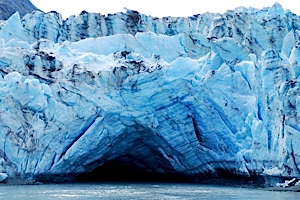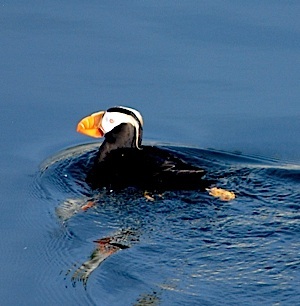It was a familiar sound, and yet unfamiliar. I was out of place: heading into the woods at Bartlett Cove along the coast of Glacier Bay National Park in Alaska, not the Rocky Mountains, and the whooshing sound startled me.
Struggling momentarily to understand what I had heard, it quickly dawned on me: A humpback whale had just surfaced, cleared its lungs through its blowhole to take another breath, and then dived back into the depths of the bay. It was a welcome on par with stepping out of the Old Faithful Inn at Yellowstone National Park and being greeted by a bugling elk or a howling wolf.
Surrounded by the dense undergrowth of the coastal rain forest, with humpbacks swimming in the cove just steps away, my introduction to Alaska and Glacier Bay couldn't have been more fitting. Sure, it rains more often than not. One account says you'll encounter at least two days of rain or showers out of three, and that the third day more often than not will be cloudy. But if you approach your visit knowing that's the case, and prepare for wet weather, it's no reason to ruin your visit.
Though the park's name spins visions of icy rivers, in truth that's just one aspect of this 3.3-million-acre prize of the National Park System.
Glaciers were the dominant feature when Capt. James Cook sailed by in 1778 and couldn't even reach today's Bartlett Cove because the Grand Pacific Glacier had pushed all the way past the cove and poked its frozen snout towards today's Icy Strait. But today, with the ice having retreated roughly 65 miles to the north, the Pacific Ocean has filled the bay and its spindly arms, creating habitat not only for whales but for harbor seals, sea otters, and harbor porpoises.

Sea lions idle the hours away on outcrops such as those at South Marble Island. Kurt Repanshek photo.
Also revealed by the glacial retreat are islands now serving as perches for seabirds and haul-outs for Steller sea lions, and forests graced by bald eagles and roamed by brown bears.
But Glacier Bay is more than just its waters. There are towering alpine landscapes, massive icefields, and rich coastal rain forests to explore.
Most folks coming to marvel at this landscape and collection of wildlife either take a one-day cruise through the park's waters or make the Glacier Bay Lodge their basecamp, where they stay for just two or three nights, on average.
Why so short?
Part of the reason no doubt is the lack of roads in the park. Aside from the 9-mile ribbon that runs from Gustavus, where a small airport and ferry dock are located, to the lodge at Bartlett Cove, there are no roads on this landscape. Guests arrive at the lodge with its 56 rooms -- all in outbuildings linked to the main lodge building by boardwalks -- admire the scenery during a stroll along the coast and possibly an 8-mile-roundtrip hike to Bartlett Lake, enjoy a day cruise, and are gone.
Though I did encounter a college professor from Colorado who was spending five days at the lodge with her daughters, few park visitors seem to like to linger in the peacefulness of the setting, exploring Gustavus, which really doesn't take long with its very small handful of shops and restaurants, and getting farther out into the park.
Considering the effort needed to reach the park, you'd think they might stay longer by planning a variety of activities. One full day can be spent joining a cruise on the Baranof Wind, which during the summer season leaves the dock below the lodge at 7:30 a.m. and doesn't return until 3 p.m. or so.

Lamplugh Glacier is slowly being undercut by a melt-water stream. Kurt Repanshek photo.
During a voyage from the cove to the farthest reaches of open water you can navigate in Glacier Bay, a distance of roughly 65 miles one-way, you're taken past South Marble Island with its rich seabird and sea lion populations, past cliffs where mountain goats roam, beyond Lamplugh and Reid glaciers, and, if the weather and ice floes are willing, into Johns Hopkins Inlet where you might spot harbor seals relaxing on icebergs when you're not gazing at the massive Johns Hopkins Glacier.
The crew makes sure you don't starve. Indeed, the trip is akin to a floating picnic, as it opens with a continental breakfast and hot drinks followed several hours later by a rich seafood chowder floating with chunks of clams, salmon and halibut, and then again a couple hours later by sandwiches.
While the eats are good, the main attraction is the bay and its wildlife. We passed otters floating on their backs while munching on sea urchins, a plenitude of birds -- Common Murre, tufted and horned puffins, Marbled murrelets, Black-legged Kittiwaks, Glaucous-winged gulls, Pigeon guillemots and more -- at South Marble Island, and even a small pod of orca whales.
"T2," an orca bull biologists have been tracking since the mid-1980s, showed up with several other orcas not long after we left South Marble in our wake. The bull, with a distinctive doral fin that flops to one side, is estimated to be 50-60 years old, said Ranger Linda Lieberman, who throughout the day provided ongoing interpretation of the wildlife and landscapes that filled our viewfinders and binoculars.
While the massive cruise ships that navigate the bay are prevented from entering Johns Hopkins Inlet due to their size, the Baranof Wind can if conditions are just right. And on this mid-August day, they were just right.

Tufted puffins are among the seabirds to be seen in Glacier Bay. Kurt Repanshek photo.
We were treated to blue skies, snowy-mountain tops, and an inlet that appeared as a punch bowl chockful of ice cubes. With the ship stopped, we listened as the Johns Hopkins Glacier calved, to ice-melt dumping into the inlet from smaller glaciers that did not quite reach the water, and birds.
During the return trip to Bartlett Cove, we spotted dozens of otters and harbor seals, bald eagles, the many species of seabirds, and humpback whales filling the air with their misty exhalations. Also visible on the shore, thanks to Ranger Lieberman's mention, were the bony remains of what had been a humpback carcass that had washed ashore near Scidmore Cut in 2010.
Exploring Glacier Bay on the Baranof Wind exposes far more of the park than you will see if you never left Glacier Bay Lodge and the shores of Bartlett Cove. And, not surprisingly, the cruise raises questions. Questions about glacial retreat and climate change, of John Muir's tenacity in 1879 when he ventured upon its waters in a canoe, and of the hardiness of kayakers who set out to explore the park -- sometimes for two weeks or more.
Another question that comes to mind is the use of cruise ships that can haul hundreds, if not thousands, of passengers, to tour Glacier Bay. These vessels make it possible for so many people to see the park's glacial wonders. Yet there are concerns of how their wakes impact resources. Waves coming ashore are said to have flushed brown bears away from their meals, and they also can speed erosion in some areas.
What should you consider if planning a visit to Glacier Bay? Beyond day cruises, you also can try your hand at kayaking, or if you're already skilled and equipped can plan a multi-day or week outing in the park. And, of course, there's always fishing for salmon and halibut.
Glacier Bay is a massive, wonderful park, one that invites exploration, whether you have only a few days, or weeks on end.


 Support Essential Coverage of Essential Places
Support Essential Coverage of Essential Places







Comments
Welcome to the beauty that is Alaska!
My wife and I just returned from a nice weekend trip to Glacier Bay. After five years living in Alaska, and now a month before moving elsewhere, it was great to finally get to visit this National Park. It is truly a world class site, and sight. The magnitude of what one sees is truly beyond simple description. We spent one day where I was out all day sport fishing while she hiked and biked. The day boat on our second day was everything we could have hoped for. In this 6-8 hour excursion, we saw eagles, orca, humpbacks, sea lions, mountain goats, a lone wolf and a lone wolverine, puffins, and many other waterfowl. We got close to several glaciers, and thanks to the park ranger on board discovered that the birds swarm when a glacier calves off into the water, and it stirs up plankton and other tasty goodies the birds loved.
We stayed at the lodge, and I must say Aramark is not really looking good to us. The beds were lousy enough that we both woke up with back and neck pain every day, and per unofficial discussion with staff members we were told that we had the good beds, and that theirs were even worse. Despite our checking several times at the lodge, word and supplies to accommodate a food allergy/sensitivity situation on the day boat meant that a crew member offered her personal food for my wife's lunch. Kudos to the person who helped out; poo to Aramark for the lousy coordination.